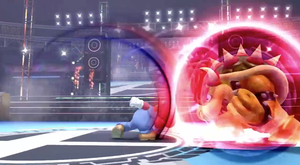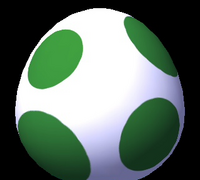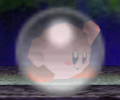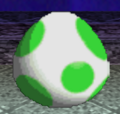Shield: Difference between revisions
Tag: Mobile edit |
(better wording maybe) |
||
| Line 4: | Line 4: | ||
[[File:BowserShieldSSB4.png|Bowser shielding in {{forwiiu}}.|thumb|300px]] | [[File:BowserShieldSSB4.png|Bowser shielding in {{forwiiu}}.|thumb|300px]] | ||
A '''shield''' (known as '''Guard''' by certain technical processes) is | A '''shield''' (known as '''Guard''' by certain technical processes) is a bubble of energy that encircles the user. A shield blocks all moves (with the exception of [[grab]]s and other [[unblockable attack]]s). <!--PLEASE DON'T add "Final Smashes" to this page nor change this to "Final Smashes". There are lots of moves that aren't Final Smashes in Super Smash Bros. Brawl, Super Smash Bros. 4, and Super Smash Bros. Ultimate which are unblockable attacks, or in other words, a very few characters have an unblockable attack outside of these cases.--> The shield is raised by pressing a certain button, which is (by default): | ||
*the [[Z button]] on the [[N64 controller]] and [[Wii Remote]] with the Nunchuk | *the [[Z button]] on the [[N64 controller]] and [[Wii Remote]] with the Nunchuk | ||
*the [[L button|L]] or [[R button]] on the [[GameCube controller]], [[Classic Controller]], [[Wii U Pro Controller]], and [[Wii U GamePad]] | *the [[L button|L]] or [[R button]] on the [[GameCube controller]], [[Classic Controller]], [[Wii U Pro Controller]], and [[Wii U GamePad]] | ||
Revision as of 00:02, September 2, 2019

A shield (known as Guard by certain technical processes) is a bubble of energy that encircles the user. A shield blocks all moves (with the exception of grabs and other unblockable attacks). The shield is raised by pressing a certain button, which is (by default):
- the Z button on the N64 controller and Wii Remote with the Nunchuk
- the L or R button on the GameCube controller, Classic Controller, Wii U Pro Controller, and Wii U GamePad
- the B button on the standalone Wii Remote
- the R button on the Nintendo 3DS, or, on New 3DS models only, the ZL button
- the ZL or ZR button on the Switch Pro Controller and dual Joy-Cons
- the SR button on a standalone Joy-Con
Shielding can only be done on the ground; pressing a shield button in midair produces an air dodge instead (or has no effect in Smash 64). Shields cannot be held forever; they shrink as time passes and attacks are blocked, and break when held for too long, causing the user to do a shield jump (popping them into the air before stunning them). Otherwise, they recharge when not in use.
In Brawl and SSB4, when an attack hits a shield, a bit of the shield can be seen visually shattering, with pieces flying away. If the Control Stick is tilted slightly, the shield can be shifted to help block attacks from specific directions. If the Stick is pushed further, the shield can be cancelled into a spotdodge or roll. In Super Smash Bros. Ultimate, if both shield buttons are pressed, or if a shield button is pressed alongside the special move button, the shield can be shifted without worrying about accidentally dodging.
In Super Smash Bros., the shield colors are different; they are always red, green, blue and grey for players 1–4 respectively, regardless of human/CPU settings. The color of a shield is based on the team color of the user; when not in a team battle, shields are red, blue, yellow, green, orange, cyan, purple and slate for players 1–8, respectively, and gray for computer players. On a related note, Super Smash Bros.' prototype, Dragon King, featured the player's colors as red, green, blue and gray in that exact order.
Technical details
Though shields block most attacks without fail and come out instantly, their shrinking causes them to not always cover the character's entire damageable hurtbox—thus, the user is still vulnerable to shield stabbing. Shields are considered to be both aerial and grounded; therefore they can be struck by both aerial and grounded-only hitboxes. If a projectile hits a shield at just the right angle, it will be deflected rather than blocked. The initial raising of the shield creates a small energy wave; if that wave hits a projectile, it will be reflected at an angle, though without harming the projectile user.
In all Super Smash Bros. games to date, shields come out on the very first frame the input for it is recognized by the game, making them extremely fast and reliable for defending against attacks, as only a select few attacks come out on frame 1, and many attacks can be easily punished after being shielded. Due to this characteristic, simply approaching an opponent in a rushed way with a move like a dash attack—a common mistake among new players to the series—is very rarely a viable tactic; the player is instead encouraged to win the neutral game by getting in close more strategically, being aware of the different options their foe has, then attack when they are unable to put up their shields, often by enforcing them to commit mistakes. Grabs are also effective at ruining foes' attempts to shield attacks if the player can properly predict them. Despite coming out on frame 1, shields in all games are still subject to display lag, meaning they will not be activated at the exact same moment the player inputs them; this often causes the impression that an attack was not shielded even though the button was pressed.
Other properties
When the shield is hit by an attack, the user will undergo an inactionable period known as shieldstun, which duration depends on the damage the attack would have done if it had been unshielded. Both the defender and (in a smaller proportion) the attacker are also pushed back; being pushed off an edge while shielding causes edge slipping.
Certain attacks have increased shield damage, meaning that they deal more damage to shields than to other targets. The Fan is one example, whose smash attack can break a shield in one hit. On the other hand, some attacks deal reduced damage to shields; this is exclusive to certain strong attacks in Smash 64, such as the Hammer.
While shielding in Melee, one can adjust the depression of the L or R button to alter the density of the shield. A light shield will cover a wider area and shrink more slowly than a dense shield, but the user will skid back a larger distance when hit. If one uses the Z button to shield, the shield will be maximum size, however this shield will take a bit longer to put up, as the character will try to grab first. Variable shield density was removed in later games, presumably because it can only be used with a GameCube Controller or the original Wii Classic Controller (no other controller has analog buttons).
If a shield is fully raised and blocks an incoming attack during the first 4 frames (3 in SSB4), the attack will be powershielded, resulting in the shield taking no damage. In Melee, powershielding can also reflect projectiles back to opponents at half their usual damage during the first 2 frames, and in SSB4, powershielding reduces shieldstun by 25% after the 1.1.1 patch. In Ultimate, powershielding is instead done by dropping the shield some time after it is raised, with a window of 5 frames after the attack connects, and has higher rather than lower shieldstun.
| Max HP | Depletion per sec. | Regeneration per sec. | Reset when broken | |
|---|---|---|---|---|
| Smash 64 | 55 | 3.75 (0.0625 per frame) | 6 (0.1 per frame) | 30 |
| Melee | 60* | 8.4 (0.14 per frame) | 4.2 (0.07 per frame) | 30 |
| Brawl | 50* | 16.8 (0.28 per frame) | 4.2 (0.07 per frame) | 30 |
| SSB4 | 50** | 7.8 (0.13 per frame) | 4.8 (0.08 per frame) | 25 |
| Ultimate | 50** | 9 (0.15 per frame) | 4.8 (0.08 per frame) | 25 |
* Receives 0.7× damage from attacks. Additional shield damage is not reduced in this way.
** Receives 1.19× damage from attacks. [1]
The comparatively strong shields in Smash 64 may be tied into the reason as to why said game's throws are rather powerful; having strong throws would discourage players from overusing their powerful shields. Furthermore, if an attack hits a shield in Smash 64, any throws done out of a subsequent shield grab will only do half damage, reducing viable out of shield options. On the other hand, shields in SSB4 are notoriously fragile, and can break very easily against moves with high shield damage such as Bowser Bomb or Ganondorf's up tilt, which discourages their overuse unless the player can powershield precisely. However, shields in SSB4 are also the second fastest at regenerating, and the second slowest at depleting when held, meaning that one does not have to wait as long before reusing their shield, and also does not have to worry about beginning to shield to block an incoming attack too early. Ultimate's shield health mechanics are largely unchanged, however shields now deplete slightly more quickly, discouraging excessively holding shield.
Shield breaking
Each character has a shield with a particular size and strength. With each hit inflicted within a period of time, the shield will diminish until it is broken. This results in the character being thrown into the air, and being stunned for a few moments after landing. Stun time is dependent on damage; characters with more damage will be stunned for less time. This phenomenon is known as a shield break.
The purpose of a shield breaking is, along with grabbing, to prevent a player from staying in his or her shield indefinitely. Instead, the shield will get smaller and smaller, exposing more of the character to attack until either the character suffers a shield stab or the entire shield is depleted. Shield breaking moves are either ones that can be comboed to prevent a character from rolling out or from dropping the shield without being hit or ones that deal enough shield damage to break the shield in one hit. Certain moves, like Marth's fully charged Shield Breaker, can break shields in one hit. Items like the Fan and Mr. Saturn are also very effective shield breakers.
If a character's shield breaks while at the very edge of a stage, the possibility of the character being stunned until falling into a KO can occur. The knockback of some moves when breaking the shield transfers to the opponent, thus pushing the character with the broken shield off the edge.
Players who use Jigglypuff should be especially careful about its shield breaking. Like other characters, if Jigglypuff's shield breaks, Jigglypuff will fly upward and then be stunned for a short period of time. However, Jigglypuff flies several hundred times farther upward than normal. This is more than enough to KO Jigglypuff, unless there is an overhead obstruction (in which case, it will helplessly keep trying to float up until several seconds have passed, the obstacle is removed, or Jigglypuff is smacked out of it).
Players who use Rosalina & Luma are still able to control Luma's attacks even if Rosalina is stunned from a shield break.
Options from the shield
When holding their shield, characters do not have all the same options as they do while standing, but they are still able to use many moves. A character can roll to reposition themselves while retaining intangibility. From Melee onward, if a player predicts that the enemy will grab to penetrate their shield, they can quickly spotdodge to avoid the grab.
Characters can also grab and jump out of their shield. Grabbing after blocking an attack is a prevalent technique known as shield grabbing—it allows one to quickly retaliate against an enemy attacker. Jumping from the shield allows characters to immediately SHFFL, wavedash or jump-cancel into their up smash or up special move. All these offensive and defensive options make shielding the centerpiece to a player's defensive game. Characters can also simply drop their shield and use any attack afterwards, though this comes with the disadvantage of having to wait either 7 frames in Smash 64, Brawl, and Smash 4, 11 frames in Ultimate, or 15 frames in Melee, while all other listed actions can be done instantly out of the shield. In Ultimate, jump-cancelling out of shield for up smash or up special moves is no longer necessary, though the control stick must still be flicked upwards for up special moves to come out of shield. In Smash 4, one's shield cannot be dropped until the shield has been up for 11 frames.
Similar to the dash-cancel, characters can activate their shield while dashing, resulting in a short slide from the momentum. A character can also dash toward an opponent, feigning a rush, and then shield; the opponent may fall for the feint and try to retaliate, leaving him or her open to the rusher's real attack. In Smash 64 and Brawl, a technique known as dashing shield allows characters to conserve more forward momentum when shielding.
Greninja's Shadow Sneak can be used while shielding, but the shield will be turned off when doing so.
Character-specific
Yoshi's shield

Yoshi has a different shield from that of other characters'. Instead of using a bubble, he uses an egg for protection. This egg does not shrink, preventing any attempts at shield stabbing. Instead, as it weakens, the egg darkens from white to dark red (similar to the colour of the percentage meters), or, in Brawl, SSB4, and Ultimate, gradually gets darker (due to eggs coming in multiple colors, including red). The egg prevents Yoshi from jumping out of his shield in Melee and Brawl, glide tossing in Brawl, and shield platform dropping in SSB4. When lightshielding in Melee, Yoshi will slide a huge distance when attacked (possibly across the entire stage). Also, Yoshi has been known to randomly perfect shield (not completely understood, but may have something to do with the egg remaining full size), and is also invincible during his shielding animation. Given the fact that Yoshi cannot jump out of his shield in Melee and Brawl, in addition to his shieldgrab being slow, his out of shield game is much more limited than the rest of the cast, resulting in much more difficulty dealing with shield pressure. This is significantly toned down in SSB4, although he now lacks the option to shield drop through platforms.
Jigglypuff's shield
While having a very large shield compared to its size, Jigglypuff's shield can cause catastrophic effects for the user if broken. Its leap—the force it is sent upwards with if its shield breaks—is equivalent to taking 300 units of vertical knockback (936.8391 units in SSB4), which is more than enough to OHKO. If nothing stops it, Jigglypuff will self-destruct. This phenomenon is known as the Shield Jump and it can be helpful in some areas such as the Brinstar Escape Shaft in Melee's Adventure Mode and The Glacial Peak in the Subspace Emissary.
Inkling's shield
Some of Inkling's attacks consume ink, and are either weaker or completely unusable when ink runs out. The Ink Tank can be refilled by pressing and holding the special button while shielding. Inkling enters a unique animation, which involves changing into squid form and recharging ink from the ground. However, during this animation, Inkling is vulnerable to attacks, albeit with a hurtbox that is half of the usual height. Otherwise, Inkling’s shield functions just like any other shield.
Origin
The concept of blocking attacks is a standard amongst the fighting game genre. In traditional fighting games, blocking involves characters bracing against attacks (such as by holding up their arms), which typically prevents the character from flinching or being affected by any of the attack's effects or gimmicks. Blocked attacks may still deal minimal damage referred to as "chip damage" depending on the game and/or type of attack blocked (normally applies to damaging special moves), and blocking too many attacks can break the character's guard and leave them vulnerable. Many fighting games require players to choose between blocking high or low attacks and do not allow players to block grabs or attacks from behind.
In Kirby Super Star, Kirby is capable of blocking attacks in a way reminiscent of most traditional fighting games—protecting him from flinching or losing his ability while still dealing minor damage if the attack is strong enough—though he automatically guards from all directions. In addition, if Kirby has the Mirror ability, guarding produces a multi-colored bubble around his body that blocks all non-grab attacks without chip damage and is even capable of reflecting certain projectiles. It is this bubble that appears to be the inspiration for the shield bubble in the Super Smash Bros. series.
Yoshi's shield design, on the other hand, is possibly based on an occurrence in Super Mario World 2: Yoshi's Island. When Baby Mario grabs a Super Star and starts running around, Yoshi follows by hiding in an egg and becoming part of his egg trail. The duo is invincible during this time. The shield may also be based on Yoshi becoming invincible once swallowing a Turbo Tulip in Yoshi's Story, although that is generally attributed to the Egg Roll instead. It is unknown why Yoshi is the only character to have a unique shield.
Gallery
A CPU Kirby shielding in Smash 64.
Captain Falcon shown angling his shield upward in Smash 64 to block an incoming attack from Samus.
Yoshi's shield in Smash 64.
Mario's shielding animation in Melee.
Mario's stunned animation in Melee.
Zero Suit Samus shields to defend herself against Snake's attack.
Mii Fighters shielding in Ultimate.











